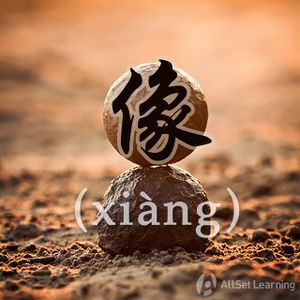Difference between revisions of "Comparing "kanqilai" and "kanlai""
| Line 37: | Line 37: | ||
<div class="liju"> | <div class="liju"> | ||
| − | *你 姐姐 真 漂亮 !<em>看起来</em> <strong>像</strong> 明星 。<span class="pinyin">Nǐ jiějie zhēn piàoliang! <em> | + | *你 姐姐 真 漂亮 !<em>看起来</em> <strong>像</strong> 明星 。<span class="pinyin">Nǐ jiějie zhēn piàoliang! <em>Kànqǐlái</em> <strong>xiàng</strong> míngxīng.</span><span class="trans">Your big sister is so pretty! She looks like a celebrity.</span> |
| − | *这 件 事 <em>看起来</em> <strong>像</strong> 骗 人 的 。<span class="pinyin">Zhè jiàn shì <em> | + | *这 件 事 <em>看起来</em> <strong>像</strong> 骗 人 的 。<span class="pinyin">Zhè jiàn shì <em>kànqǐlái</em> <strong>xiàng</strong> piàn rén de .</span><span class="trans">This whole thing looks like it's meant to scam people.</span> |
| − | *他们 <em>看起来</em> 不 <strong>像</strong> 好 人 。<span class="pinyin">Tāmen <em> | + | *他们 <em>看起来</em> 不 <strong>像</strong> 好 人 。<span class="pinyin">Tāmen <em>kànqǐlái</em> bù <strong>xiàng</strong> hǎo rén.</span><span class="trans">They don't look like good people.</span> |
| − | *他 <em>看起来</em> <strong>像</strong> 不 <strong>像</strong> 我 的 那个 朋友 ?<span class="pinyin">Tā <em> | + | *他 <em>看起来</em> <strong>像</strong> 不 <strong>像</strong> 我 的 那个 朋友 ?<span class="pinyin">Tā <em>kànqǐlái</em> <strong>xiàng</strong> bu <strong>xiàng</strong> wǒ de nàge péngyou?</span><span class="trans">Does he look like that friend of mine?</span> |
</div> | </div> | ||
Latest revision as of 03:34, 29 December 2020
-
Level
-
Similar to
-
Used for
-
Keywords
Both 看起来 (kànqilai) and 看来 (kànlái) are related to how something "looks," but they are used in different ways. Whereas 看起来 indicates an appraisal of a physical situation, 看来 expresses a user's understanding of a situation.
Contents
看起来 Describes a Physical Appearance
看起来 is used to describe physical appearances. In other words, one can use 看起来 to literally describe what something "looks like."
Structure
Subj. + 看起来 ⋯⋯
Examples
- 女儿 今天 看起来 很 开心 。Our daughter looks really happy today.
- 这 道 菜 看起来 很 好吃。This dish looks really tasty.
- 这 两 件 衣服 看起来 差不多 一样 。These two pieces of clothing look pretty much the same.
- 老板 最近 太 忙 了,他 看起来 很 累。The boss has been too busy lately. He looks really tired.
看起来 + 像 for Direct Visual Comparisons
看起来 can also be used to express how something "looks like" something else. But unlike the previous usage of 看起来, and with the help of 像, we can explicitly state what the object looks like.
Structure
Subj. + 看起来 + 像 ⋯⋯
Examples
- 你 姐姐 真 漂亮 !看起来 像 明星 。Your big sister is so pretty! She looks like a celebrity.
- 这 件 事 看起来 像 骗 人 的 。This whole thing looks like it's meant to scam people.
- 他们 看起来 不 像 好 人 。They don't look like good people.
- 他 看起来 像 不 像 我 的 那个 朋友 ?Does he look like that friend of mine?
看来 When Assessing a Situation
看来 can be used to express one's interpretation of a situation. Note that when 看来 is used in a manner, the speaker isn't usually commenting on the visual or physical appearance of anything. Rather, 看来 indicates the speaker's perspective or conclusion about how a situation "looks."
Structure
看来 + Perspective
Examples
- 雨 这么 大,看来 他 不 来 了。It's raining so hard. It seems he's not coming.
- 这 家 餐厅 人 很 少, 看来 不 太 好吃。There aren't many people at this restaurant. It seems the food isn't so good.
- 现在 看来,他 没有 那么 喜欢 你。It seems now that he's just not that into you.
看来 as "From X's Perspective"
看来 can also be used to make a subjective statement from a particular person's perspective. A more literal translation would be "the way [Person] sees it...." This full form is more common in formal writing and speaking.
Structure
在 + Person + 看来 + Perspective
Examples
- 在 我 看来,最 好 的 办法 是 大家 一起 合作。The way I see it, the best solution is for everyone to cooperate.
- 在 他 看来,这 件 事情 很 简单。From his perspective, this is a very simple matter.
See Also



